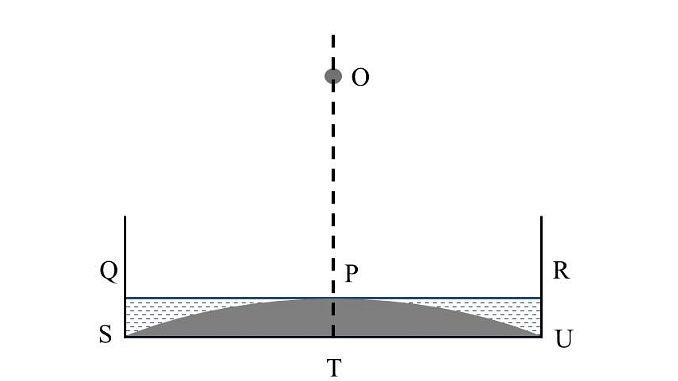Question:
A biconvex lens of focal length f forms a circular image of
radius r of sun in focal plane. Then which option is correct ?
A biconvex lens of focal length f forms a circular image of
radius r of sun in focal plane. Then which option is correct ?
Updated On: May 24, 2022
- $\pi r^2 \propto f$
- $\pi r^2 \propto f^2$
- If lower half part is convered by black sheet, then area of the image is equal to $\pi r^2/2$
- If f is doubled, intensity will increase
Hide Solution
Verified By Collegedunia
The Correct Option is B
Solution and Explanation
$\hspace25mm r=f \, tan \, \theta$
or $\hspace25mm r ? f \, \therefore \, \, \, \, \pi r^2 ? f^2$
or $\hspace25mm r ? f \, \therefore \, \, \, \, \pi r^2 ? f^2$
Was this answer helpful?
0
0
Top Questions on spherical lenses
- A glass beaker has a solid, plano-convex base of refractive index 1.60, as shown in the figure. The radius of curvature of the convex surface (SPU) is 9 cm, while the planar surface (STU) acts as a mirror. This beaker is filled with a liquid of refractive index n up to the level QPR. If the image of a point object O at a height of ℎ (OT in the figure) is formed onto itself, then, which of the following option(s) is(are) correct?

- JEE Advanced - 2024
- Physics
- spherical lenses
- A small telescope has an objective of focal length 140 cm and an eye piece of focal length 5.0 cm. The magnifying power of telescope for viewing a distant object is :
- NEET (UG) - 2024
- Physics
- spherical lenses
- If a biconvex lens of material of refractive index 1.5 has focal length 20 cm in air, then its focal length when it is submerged in a medium of refractive index 1.6 is
- JEE Main - 2024
- Physics
- spherical lenses
- Radius of curvature of equiconvex lens is 20 cm. Material of lens is having refractive index of 1.5. Find image distance from lens if an object is placed 10 cm away from the lens.
- JEE Main - 2024
- Physics
- spherical lenses
- In a convex mirror having radius of curvature \(30\) \(cm\) the height of image is half the object height. What will be the object distance (in cm)?
- JEE Main - 2024
- Physics
- spherical lenses
View More Questions
Questions Asked in JEE Advanced exam
- A region in the form of an equilateral triangle (in x-y plane) of height L has a uniform magnetic field 𝐵⃗ pointing in the +z-direction. A conducting loop PQR, in the form of an equilateral triangle of the same height 𝐿, is placed in the x-y plane with its vertex P at x = 0 in the orientation shown in the figure. At 𝑡 = 0, the loop starts entering the region of the magnetic field with a uniform velocity 𝑣 along the +x-direction. The plane of the loop and its orientation remain unchanged throughout its motion.

Which of the following graph best depicts the variation of the induced emf (E) in the loop as a function of the distance (𝑥) starting from 𝑥 = 0? - Two beads, each with charge q and mass m, are on a horizontal, frictionless, non-conducting, circular hoop of radius R. One of the beads is glued to the hoop at some point, while the other one performs small oscillations about its equilibrium position along the hoop. The square of the angular frequency of the small oscillations is given by [ \(\epsilon_0 \)is the permittivity of free space.]
- JEE Advanced - 2024
- Moving charges and magnetism
- A group of 9 students, s1, s2,…., s9, is to be divided to form three teams X, Y and Z of sizes 2, 3, and 4, respectively. Suppose that s1 cannot be selected for the team X and s2 cannot be selected for the team Y. Then the number of ways to form such teams, is _______.
- JEE Advanced - 2024
- Combinations
- Let \(\vec{p}=2\hat{i}+\hat{j}+3\hat{k}\) and \(\vec{q}=\hat{i}-\hat{j}+\hat{k}\). If for some real numbers α, β and γ we have
\(15\hat{i}+10\hat{j}+6\hat{k}=α(2\vec{p}+\vec{q})+β(\vec{p}-2\vec{q})+γ(\vec{p}\times\vec{q})\),
then the value of γ is ________.- JEE Advanced - 2024
- Vector Algebra
- Let X be a random variable, and let P(X = x) denote the probability that X takes the value x. Suppose that the points (x, P(X = x)), x = 0,1,2,3,4, lie on a fixed straight line in the xy -plane, and P(X = x) = 0 for all x ∈ R - {0,1,2,3,4}. If the mean of X is \(\frac{5}{2}\) , and the variance of X is α, then the value of 24α is ______.
- JEE Advanced - 2024
- Probability
View More Questions
Concepts Used:
Spherical Lenses
Lenses that are made by combining two spherical transparent surfaces are called spherical lenses. In general, there are two kinds of spherical lenses. Lenses that are made by joining two spherical surfaces that bulge outward are convex lenses, whereas lenses that are made by joining two spherical surfaces that curve inward are concave lenses.
Properties of Convex lens:
- In this, the lenses are thicker in the middle and thinner at the edges.
- They have a positive focal length.
- It intersects the incident rays towards the principal axis
- These lenses are used in the camera, focus sunlight, projector microscope, simple telescope, overhead projector, magnifying glasses, etc.
Properties of Concave lens:
- These lenses are thinner in the middle and thicker at the edges.
- They have a negative focal length.
- It parts the incident rays away from the principal axis.
- These are used in the glasses, spy holes, some telescopes in the doors, etc.



